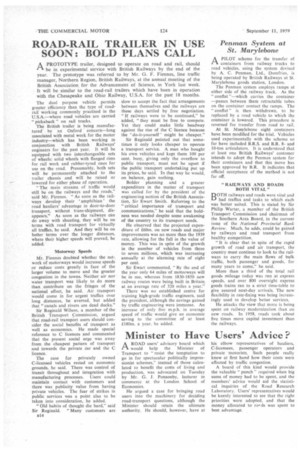Penman System at St. Marylebone
Page 48

If you've noticed an error in this article please click here to report it so we can fix it.
APILOT scheme for the transfer of containers from railway trucks to road vehicles, using the system devised by A. C. Penman, Ltd., Dumfries, is being operated by British Railways at St. Marylebone goods station, London.
The Penman system employs ramps at either side of the railway track, As the " conflat "—which carries the container —passes between them retractable tubes on the container contact the ramps. The " conflat " is then withdrawn, to be replaced by a road vehicle to which the container is lowered. This procedure is reversed for transfer from road to rail.
At St. Masylebone eight containers have been modified for the trial. Vehicles used experimentally with the scheme so far have included B.R.S. and B.R. 8and 10-ton articulators. It is understood that at least one British Railways' customer intends to adopt the Penman system for their containers and that this move has been approved by B.R. It indicates that official acceptance of the method is not far off.
"RAILWAYS AND ROADS BOTH VITAL" DOTH railways and roads were vital and had traffics and tasks to which each was better suited. This is stated by Sir Philip Warter, a member of the British Transport Commission and chairman of the Southern Area Board, in the current issue of the National Provincial Bank Review. Much. he adds, could be gained by railways and road transport from healthy competition.
"It is clear that in spite of the rapid growth of road and air transport, the country must continue to look to the railways to carry the main flows of bulk traffic, both passenger and goods, for many years to come," he said.
More than a third of the total rail goods mileage today was run at express speeds, and over 800 overnight express goods trains ran to a strict time-table to give assured next-day arrivals. The new flexibility in rate-fixing was being increasingly used to develop better services.
He attacks the view that more is being spent on railway modernization than on new roads. In 1958, roads took about five times more capital investment than the railways.




























































































































































